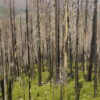Humans, like all mammals, expend energy to keep their internal temperatures within a healthy range. Modern human cities—because we built them that way—do the same thing.
A study published in the journal PLOS Climate takes a new look at how household energy use changes with rising temperatures, applying a model traditionally used for studying animals.
For urban planners, energy companies and emergency managers, the work has implications for energy grid security, cost predictions and saving lives from heat waves. And for the University of Arizona senior who is the study’s lead author, the project is the culmination of an undergraduate career and a steppingstone on her path to helping communities become more resilient to environmental change.
An ‘itch to do research’
Halley Hughes is a research assistant in the Bridging Biodiversity and Conservation Science program at the university’s Arizona Institute for Resilience. She began the work that led to the journal article at the height of pandemic lockdowns. She was bored and said she had “that itch to do research.”
Hughes applied an approach that treats buildings—and on a larger scale, cities—as if they are living things. In a way, she said, it makes sense.
“Humans made buildings, and we use buildings to maintain a normal temperature for us. To do that, the buildings use external energy in the form of fossil fuels or, if you’re lucky, alternative energy sources,” she said.
The approach was pioneered by Richard Hill, a now retired biologist at Michigan State University who applied a mathematical model developed for studying how mammals regulate their body temperatures to an entirely new area: investigating how humanmade infrastructure uses energy in the same way to regulate internal spaces in cold climates.
Hughes’ study extends Hill’s work and applies the model to look at effects of hot weather on energy use in buildings.
“Dr. Hill looked at cold places,” she said. “We looked at all of Arizona, which includes cities that can get as hot as 120 degrees Fahrenheit.”
Hughes used publicly accessible data from 10 large energy companies in Arizona to look at energy usage in relation to outside temperature for a large majority of the state’s population. Her results show that buildings require more energy to regulate internal temperatures when it’s hotter. Hughes has demonstrated that merging science disciplines to study urban energy consumption can give city planners effective tools to prepare for high temperatures.
The ‘benefit of our differences’
A key benefit of this work is that it can be used to predict future energy needs, Hughes said. For energy companies, she explained, knowing the energy needs of a service area in advance could help prevent events such as rolling blackouts.
“The general pattern documented here and its match to the more general theory is really exciting and powerful to see,” added her mentor, Dave Breshears, a Regents Professor in the School of Natural Resources and the Environment.
Hughes also found indications of energy insecurity in lower income neighborhoods by comparing per capita income from census data to her map of energy use.
“In these places, people likely are delaying turning on their energy to save money,” she said, “which could be increasingly dangerous if energy costs and temperatures continue to rise.”
Study co-author Ladd Keith, a UArizona assistant professor of planning and sustainable built environments in the College of Architecture, Planning and Landscape Architecture and a faculty research associate at the Udall Center for Studies in Public Policy, agreed.
“This study provides important context for heat planning and governance as heat risk in our communities continues to increase due to climate change,” he said.
Because Hughes used open-access data from national and university datasets, anyone can repeat or replicate the study, meaning that the research could be applied to any region nationwide.
In addition to Hughes, Breshears and Keith, Kimberly Cook, a library and information scientist and doctoral candidate in the University of Kentucky Department of Biology, contributed to the paper. And Joseph Robert “Robbie” Burger, a former postdoctoral fellow with the Bridging Biodiversity and Conservation Science program, contributed the idea to apply Hill’s approach to study cities stressed by heat.
“Interdisciplinary work in research is so critical to providing really insightful and useful results,” Hughes said, noting that she appreciated how the authors brought diverse areas of expertise to her study. “All these different interpretations helped us understand more about the data. It was a huge benefit of our differences.”
Hughes, an honors student, will graduate this year with a double major in global change ecology and urban and regional development from the College of Agriculture and Life Sciences. Her honors thesis investigates impacts of heat on energy use in manufactured homes in Tucson.
She hopes her experience in research and early publication can help inspire other undergraduate students to get involved in science as well.
“Undergraduates should not be intimidated by research,” she said. “It’s an empowering process, and there are so many opportunities at the University of Arizona to be involved in science.”
To her fellow undergraduates, she suggests: “Don’t hesitate starting research just because you’re an undergrad. You can author a paper, too.”
The UArizona Undergraduate Research Task Force aims to connect all university students with diverse research opportunities.
In addition to her love of science, Hughes also is passionate about science communication, an interest she furthers as a Liverman Scholar with Arizona Institute for Resilience’s Education Initiatives and as an award-winning correspondent for Planet Forward, a project of George Washington University that teaches, celebrates and rewards effective environmental and science storytelling through a variety of media. She is co-director of UArizona Students for Sustainability and an advisory team member for the university’s new Sustainability and Climate Action Plan.
“Halley’s work is a perfect example of how our resilience initiatives in AIR (the Arizona Institute for Resilience) aim to combine education, research and impact,” said Kevin Bonine, director of AIR’s Education Initiatives program. “The internships and scholarships provided by our program empower students with real-world experiences, teaching them the ways in which they can make meaningful change in their communities and across the globe through science and environmental communication.”
More information:
Halley B. Hughes et al, Household energy use response to extreme heat with a biophysical model of temperature regulation: An Arizona case study, PLOS Climate (2023). DOI: 10.1371/journal.pclm.0000110
Provided by
University of Arizona
Citation:
How cities use energy to regulate temperature, just like mammals (2023, April 12)



